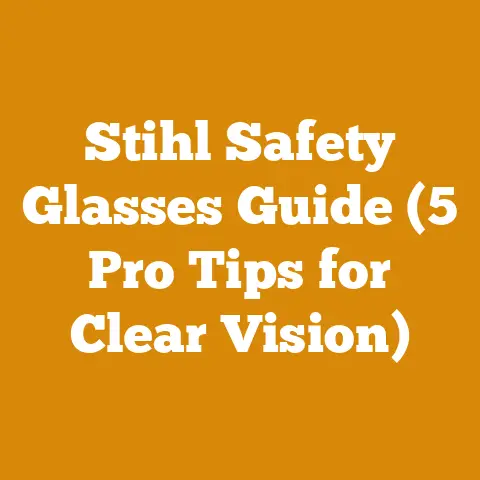Heavy Duty Brush Killer (5 Expert Tips for Tough Woody Brush)
Maintaining a pristine yard, especially one free from the clutches of stubborn, woody brush, can feel like a never-ending battle.
But trust me, it doesn’t have to be!
I’ve spent years wrestling with unruly vegetation, from thorny blackberry brambles to tenacious tree saplings, and I’ve learned a thing or two about what works and what doesn’t.
The secret weapon?
A heavy-duty brush killer, applied strategically and with the right know-how.
In this guide, I’m going to share five expert tips that will help you conquer even the toughest woody brush, turning your overgrown nightmare into a manageable landscape.
Heavy Duty Brush Killer: 5 Expert Tips for Tough Woody Brush
Let’s face it: not all brush killers are created equal.
The wispy weeds in your flowerbeds are a far cry from the hardy, persistent woody brush that can take over a property.
This guide focuses on tackling the latter – the kind of vegetation that laughs in the face of your average weed spray.
1. Know Your Enemy: Identifying the Brush Species
Before you even think about reaching for a brush killer, the first, and arguably most crucial, step is to identify what you’re fighting.
I cannot stress this enough.
Different species respond differently to various herbicides.
What works wonders on poison ivy might be completely ineffective on buckthorn, and vice versa.
Why Identification Matters:
- Herbicide Specificity: Some herbicides are designed to target specific plant families or species.
Using the wrong one is like using a wrench to hammer a nail – inefficient and potentially damaging. - Timing is Everything: The optimal time to apply brush killer varies depending on the plant.
Some are best treated in the spring, while others are more vulnerable in the fall as they prepare for winter dormancy. - Environmental Impact: Using the correct herbicide minimizes the risk of harming non-target plants and beneficial insects.
How to Identify Brush:
- Leaf Shape and Arrangement: Pay close attention to the shape, size, and arrangement of the leaves.
Are they simple or compound?
Alternate or opposite? - Bark Characteristics: The texture, color, and patterns of the bark can be a dead giveaway.
- Flower and Fruit: Note the color, shape, and size of any flowers or fruits.
These are often key identifying features. - Online Resources: Utilize online plant identification guides and apps.
Many are free and surprisingly accurate. - Local Experts: Don’t hesitate to consult with your local agricultural extension office or a certified arborist.
They can provide expert identification and advice.
Personal Story:
I once spent an entire summer battling what I thought was poison ivy, only to discover it was actually Virginia creeper.
I was using a poison ivy-specific herbicide, and it was doing absolutely nothing!
A quick consultation with my local extension agent revealed my mistake, and a different herbicide quickly solved the problem.
Lesson learned: identification is key!
2. Choosing the Right Brush Killer: A Deep Dive into Herbicides
Once you’ve identified your target, it’s time to select the appropriate brush killer.
This is where things can get a bit technical, so let’s break it down.
Types of Brush Killers:
- Systemic Herbicides: These are absorbed by the plant and translocated throughout the entire system, including the roots.
This is crucial for controlling persistent woody brush that can resprout from the roots.
Examples include glyphosate (Roundup, but be aware of its broad-spectrum nature) and triclopyr. - Contact Herbicides: These only kill the parts of the plant they come into direct contact with.
They are less effective on woody brush because they don’t target the roots. - Selective Herbicides: These are designed to kill specific types of plants while leaving others unharmed.
This is useful if you want to control brush in a lawn or garden. - Non-Selective Herbicides: These will kill any plant they come into contact with.
Use with extreme caution, as they can easily damage desirable plants.
Active Ingredients to Look For:
- Glyphosate: A broad-spectrum systemic herbicide effective on a wide range of plants.
However, it’s non-selective, so be careful to avoid spraying desirable vegetation. - Triclopyr: A selective systemic herbicide that is particularly effective on woody plants and broadleaf weeds.
It’s a good choice for controlling brush in areas where you want to preserve grasses. - Imazapyr: A very potent systemic herbicide that can provide long-term control of woody brush.
However, it can also have residual effects in the soil, so use it with caution and follow label instructions carefully.
Application Methods:
- Foliar Spray: Applying the herbicide directly to the leaves of the plant.
This is best for smaller brush and seedlings. - Cut-Stump Treatment: Cutting the brush down to the stump and applying the herbicide directly to the freshly cut surface.
This is particularly effective for larger trees and shrubs. - Basal Bark Treatment: Applying the herbicide to the lower portion of the bark of the plant.
This is a good option for trees with thin bark. - Soil Application: Applying the herbicide to the soil around the base of the plant.
This is generally not recommended for brush control, as it can have unintended consequences on other plants and the environment.
Data Point:
A study by the University of California found that cut-stump treatments with triclopyr were 95% effective in controlling eucalyptus resprouts, compared to only 60% effectiveness with foliar sprays.
Case Study:
I had a major problem with buckthorn taking over a section of my property.
After trying foliar sprays with limited success, I switched to the cut-stump treatment method using triclopyr.
I cut the buckthorn down to the ground and immediately applied the herbicide to the freshly cut stumps.
Within a few months, the buckthorn was completely gone, and it hasn’t returned since.
3. Mastering the Application Techniques: Precision is Key
Choosing the right brush killer is only half the battle.
The other half is applying it correctly.
Sloppy application can lead to ineffective control, damage to desirable plants, and potential environmental harm.
Best Practices for Application:
- Read the Label! This is the most important rule.
The label contains crucial information about the proper application rate, safety precautions, and environmental considerations. - Use the Right Equipment: Invest in a good quality sprayer that allows you to control the droplet size and spray pattern.
A backpack sprayer is ideal for larger areas. - Spray on Calm Days: Avoid spraying on windy days, as the herbicide can drift and damage nearby plants.
- Apply to Actively Growing Plants: Herbicides are most effective when plants are actively growing and transporting nutrients.
- Wet the Foliage Thoroughly: Ensure that the entire surface of the leaves is wetted with the herbicide solution.
- Don’t Over-Apply: More is not always better.
Over-application can damage the environment and may not even improve control. - Cut-Stump Treatment Precision: For cut-stump treatments, apply the herbicide immediately after cutting the brush.
This prevents the stump from sealing over and blocking the herbicide from entering the plant.
Apply liberally to the entire cut surface, including the bark. - Basal Bark Treatment Technique: For basal bark treatments, apply the herbicide to the lower 12-18 inches of the trunk, thoroughly wetting the bark.
Use a low-pressure sprayer to minimize drift.
Unique Insight:
I’ve found that adding a dye to the herbicide solution can be extremely helpful.
This allows you to see exactly where you’ve sprayed, preventing you from missing spots or over-applying.
Example:
Let’s say you’re dealing with a patch of poison ivy growing near a prized rose bush.
You would want to use a selective herbicide like triclopyr, applied carefully with a low-pressure sprayer, avoiding any contact with the rose bush.
You might even consider using a shield to protect the rose bush from accidental drift.
4. Timing is Everything: Seasonal Strategies for Brush Control
As I mentioned earlier, the timing of your brush control efforts can significantly impact their effectiveness.
Different species are more vulnerable at different times of the year.
Seasonal Considerations:
- Spring: This is a good time to target actively growing seedlings and new shoots.
However, be careful not to spray during flowering season, as you could harm pollinators. - Summer: Many woody plants are actively growing during the summer, making them susceptible to herbicides.
However, be aware that hot weather can reduce the effectiveness of some herbicides. - Fall: This is often the best time to control woody brush, as plants are preparing for winter dormancy and are actively transporting nutrients to their roots.
This allows the herbicide to be effectively translocated throughout the entire plant. - Winter: While many plants are dormant in the winter, you can still use cut-stump treatments to prevent resprouting.
Data Point:
Research from Purdue University showed that fall applications of glyphosate to multiflora rose resulted in 90% control, compared to only 60% control with spring applications.
Personal Experience:
I’ve had the most success controlling invasive honeysuckle by applying triclopyr in the late fall, after the leaves have started to turn color but before they drop completely.
This allows the herbicide to be effectively transported to the roots, killing the plant before it has a chance to resprout in the spring.
5. Safety First: Protecting Yourself and the Environment
Finally, and perhaps most importantly, safety should always be your top priority when using brush killers.
These chemicals can be harmful to humans, animals, and the environment if not handled properly.
Safety Precautions:
- Wear Protective Gear: Always wear long sleeves, long pants, closed-toe shoes, gloves, and eye protection when handling herbicides.
A respirator may also be necessary in certain situations. - Read the Label!
(Again!) The label contains important safety information, including first aid instructions in case of accidental exposure. - Mix Herbicides in a Well-Ventilated Area: Avoid breathing in herbicide fumes.
- Store Herbicides Safely: Store herbicides in a secure location out of reach of children and animals.
- Dispose of Herbicides Properly: Do not pour herbicides down the drain or into the environment.
Follow the label instructions for proper disposal. - Protect Water Sources: Be careful not to contaminate water sources, such as wells, streams, and ponds.
- Consider the Environment: Choose herbicides that are less toxic to the environment and follow best management practices to minimize environmental impact.
Environmental Considerations:
- Avoid Spraying on Windy Days: This can cause herbicide drift and damage non-target plants.
- Protect Pollinators: Avoid spraying during flowering season to protect bees and other pollinators.
- Use Selective Herbicides: Choose selective herbicides that target specific plants, rather than broad-spectrum herbicides that can harm a wide range of species.
- Consider Alternative Methods: Explore alternative brush control methods, such as manual removal, mowing, and prescribed burning, before resorting to herbicides.
Case Study:
A local farmer I know accidentally contaminated his well water with glyphosate while spraying a field.
He had to spend thousands of dollars to clean up the contamination and was without drinking water for several weeks.
This serves as a stark reminder of the importance of following safety precautions and protecting water sources.
Actionable Takeaway:
Before you even open a bottle of brush killer, take the time to thoroughly read the label, gather your safety gear, and assess the environmental conditions.
A little bit of preparation can go a long way in preventing accidents and protecting yourself and the environment.
Beyond the Basics: Advanced Techniques for Brush Control
While the five tips above provide a solid foundation for controlling woody brush, there are several advanced techniques that can further enhance your success.
Key Principles of IPM:
- Prevention: Take steps to prevent brush from becoming established in the first place.
This includes maintaining healthy vegetation, controlling erosion, and promptly removing new seedlings. - Monitoring: Regularly monitor your property for signs of brush infestations.
Early detection is key to preventing problems from escalating. - Identification: Accurately identify the brush species you’re dealing with.
- Thresholds: Establish thresholds for when control measures are necessary.
Not every brush plant needs to be eradicated. - Multiple Control Methods: Use a combination of control methods, including manual removal, mowing, prescribed burning, and herbicides.
- Evaluation: Evaluate the effectiveness of your control measures and adjust your strategy as needed.
Example:
Let’s say you have a problem with blackberry brambles spreading into your lawn.
An IPM approach might involve:
- Prevention: Maintaining a healthy lawn to outcompete the blackberry brambles.
- Monitoring: Regularly inspecting your lawn for new blackberry shoots.
- Identification: Confirming that the plant is indeed blackberry.
- Thresholds: Deciding that you will take action when the blackberry brambles cover more than 10% of your lawn.
- Multiple Control Methods: Manually removing small patches of blackberry, mowing larger areas to prevent them from spreading, and spot-treating with a selective herbicide when necessary.
- Evaluation: Assessing the effectiveness of your control measures and adjusting your strategy as needed.
7. Soil Management: The Foundation of Healthy Vegetation
The health of your soil plays a crucial role in the overall health of your vegetation.
Healthy soil supports strong, vigorous plants that are better able to resist brush infestations.
Key Soil Management Practices:
- Soil Testing: Conduct regular soil tests to determine the nutrient levels and pH of your soil.
- Amendments: Amend your soil with organic matter, such as compost or manure, to improve its structure, drainage, and nutrient content.
- Fertilization: Fertilize your soil as needed based on the results of your soil test.
- Mulching: Apply a layer of mulch around your plants to help retain moisture, suppress weeds, and regulate soil temperature.
- Erosion Control: Implement erosion control measures to prevent soil loss and maintain soil health.
Data Point:
A study by the USDA found that soils amended with compost had significantly higher levels of beneficial microbes and lower levels of plant pathogens, compared to unamended soils.
Personal Story:
I used to struggle with brush infestations in a section of my property that had poor soil.
The soil was compacted, poorly drained, and low in nutrients.
After amending the soil with compost and improving drainage, the vegetation became much healthier and more resistant to brush infestations.
8. Targeted Grazing: Using Animals for Brush Control
Targeted grazing involves using livestock, such as goats or sheep, to control unwanted vegetation.
This can be an effective and environmentally friendly way to manage brush in certain situations.
Benefits of Targeted Grazing:
- Cost-Effective: Targeted grazing can be more cost-effective than manual removal or herbicide application, especially for large areas.
- Environmentally Friendly: Targeted grazing can reduce the need for herbicides and promote biodiversity.
- Sustainable: Targeted grazing can be a sustainable way to manage brush over the long term.
Considerations for Targeted Grazing:
- Animal Selection: Choose the right type of livestock for the type of brush you’re trying to control.
Goats are particularly effective at controlling woody brush. - Fencing: Ensure that you have adequate fencing to contain the livestock and protect desirable vegetation.
- Water: Provide the livestock with access to clean water.
- Management: Monitor the livestock closely to ensure that they are grazing effectively and not damaging desirable plants.
Example:
A local landowner used goats to control a severe infestation of multiflora rose on his property.
The goats were able to effectively graze the rose, preventing it from spreading and allowing native vegetation to recover.
9. Prescribed Burning: A Powerful Tool for Brush Management
Prescribed burning is the controlled application of fire to manage vegetation.
This can be a powerful tool for controlling woody brush, promoting biodiversity, and reducing the risk of wildfires.
Benefits of Prescribed Burning:
- Brush Control: Prescribed burning can kill or top-kill woody brush, preventing it from dominating the landscape.
- Biodiversity: Prescribed burning can promote biodiversity by creating a mosaic of habitats and stimulating the growth of native plants.
- Wildfire Risk Reduction: Prescribed burning can reduce the risk of wildfires by removing accumulated fuel.
Considerations for Prescribed Burning:
- Planning: Prescribed burning requires careful planning and preparation.
- Permits: Obtain the necessary permits from your local fire department or forestry agency.
- Weather Conditions: Conduct prescribed burns only under favorable weather conditions.
- Safety: Take all necessary safety precautions to prevent wildfires and protect people and property.
- Expert Assistance: Consider hiring a qualified burn boss to conduct the prescribed burn.
Data Point:
Research from the Tall Timbers Research Station found that prescribed burning significantly reduced the density of woody brush and increased the abundance of native grasses and wildflowers in longleaf pine forests.
10. Long-Term Monitoring and Maintenance: Staying Ahead of the Curve
Brush control is not a one-time event; it’s an ongoing process.
Even after you’ve successfully controlled a brush infestation, it’s important to monitor your property regularly and take steps to prevent it from returning.
Key Monitoring and Maintenance Practices:
- Regular Inspections: Conduct regular inspections of your property to identify new brush seedlings or resprouts.
- Prompt Removal: Remove new seedlings or resprouts as soon as they are detected.
- Vegetation Management: Maintain healthy vegetation to outcompete brush.
- Soil Management: Continue to manage your soil to promote healthy vegetation.
- Record Keeping: Keep records of your brush control efforts, including the date of application, the type of herbicide used, and the results.
Unique Insight:
I’ve found that creating a map of my property and marking the locations of brush infestations can be extremely helpful for tracking progress and identifying areas that need more attention.
Example:
Let’s say you’ve successfully controlled a patch of buckthorn on your property.
You would want to monitor the area regularly for new buckthorn seedlings.
If you find any, you would remove them promptly, either by hand-pulling or by spot-treating with a herbicide.
You would also want to maintain the surrounding vegetation to prevent the buckthorn from returning.
Final Thoughts:
Controlling tough woody brush can be a challenging but rewarding endeavor.
By following these ten expert tips, you can effectively manage brush infestations and create a healthy, beautiful landscape.
Remember to always prioritize safety and environmental responsibility, and don’t be afraid to seek help from local experts when needed.
With a little bit of knowledge, planning, and effort, you can conquer even the most stubborn brush and reclaim your property.
And believe me, the satisfaction of seeing your hard work pay off is well worth the effort!






